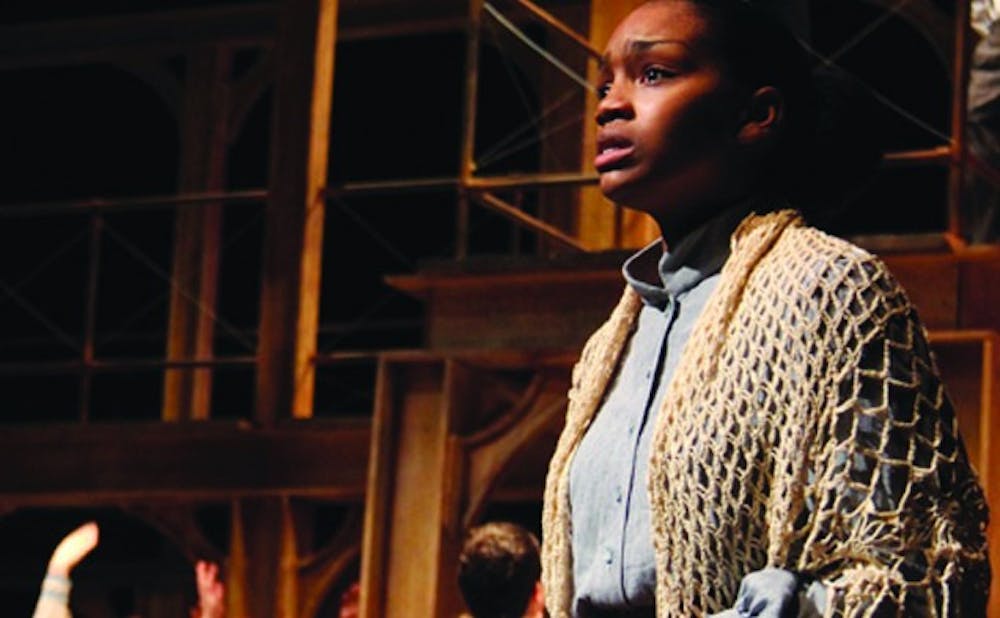Before the lights go down, it’s evident that Ragtime is not a typical Duke musical. The sheer size of the production set, which is unveiled before the start of the show, is enough to inspire curiosity, if not skepticism, among the audience. If the crew spent so much time on this set, can the play live up to its lofty structure?
The answer, unequivocally, is yes. For the first time in Duke history, a super-group of academic departments and student organizations, including Theater Studies, Music, Dance, Chamber Players and Hoof ‘n’ Horn, has come together to put on Ragtime, the Tony award-winning musical that explores themes of race, class and gender at the turn of the 20th century.
“I wanted, and Hoof ‘n’ Horn needed, a musical that would be entertaining for us to perform and we would be able to get our peers to come see,” producer and senior Nate Hill said. “Ragtime is a wild ride; it’s got explosions and kidnapping and stripping and fire. People love it.”
Hill has been working closely with various departmental staff for the past two years producing Ragtime, using this extended process, which included an associated Theater Studies course, as his senior thesis. With Ragtime, Hill will become the first student in Duke’s history to graduate with distinction in producing in Theater Studies.
Technically speaking, the set immediately indicates how huge this production is. Occupying two levels and the entire stage, the structure uses both horizontal and vertical space on the stage to the casts’ advantage.
“It’s hard to get forty people to look like they’re filling an entire stage,” said Torry Bend, the show’s set designer and an assistant professor of the practice of theater studies. “If you want to create a sense of density and population you can’t rely only on people.”
The set definitely accomplishes this feat, portraying the illusion that the already sizable cast is at least twice as big as it looks. This effectively transports the audience to the bustling shipyards of New York City. Even scenes requiring smaller locations, such as Victorian houses highlighting the racial hierarchies of the time period, demonstrate the versatility of the set. Visually, the set also has a dual function: it sometimes seems dense and overwhelming, while at other times it appears sparse and austere, highlighting the ostracism of characters in various scenes.
The large size of the set echoes that of the cast. Once the prologue begins, a barrage of early-20th century period costumes—tweed suits, dresses covering the ankles (except for the hilarious bombshell Evelyn Nesbit) and bowler hats—parades onto the set.
“At the end of the beginning number when you see forty people on stage in this huge surrounding you realize, ‘Oh, this is kind of a big deal,” said freshmen attendee Matthew Frost.
The ensemble is distinctly divided by their race and class into three groups: the Harlem locals, the Jewish immigrants and the white upper class. Sophomore Martavius Parrish and junior Jordan Rodriguez share the role of Coalhouse, a self-made African-American musician, by switching on a nightly basis. Both command the stage with a deep, bluesy croon contrasted, at various points, by demanding and powerful vocals that convey Coalhouse’s conflicted motivations that often toe the line between humanity and volatility.
Both actors sought out ways to connect Coalhouse’s personality with their own to deepen their involvement in the role. Rodriguez explained that Coalhouse is “very passionate, [which] leads him to be very prideful and short-sighted,” which Parrish admitted “is a combination of things I wish I were and things I’m glad I’m not.”
These three stories start markedly segregated yet as the world changes with the turn of the 19th century, the characters’ lives begin to intertwine. Frequently these intersections result in explosive or powerful confrontations about race, class and gender. Senior Alessandra DiMona plays Mother, a woman ahead of her time who takes in an African-American mother and child in her husband’s absence.
“Her journey throughout the show is one of liberation and self-discovery,” DiMona said.
She portrays an independent-minded woman socially ostracized for her race-blind philosophy. The dynamism of Mother’s relationships underscores her relatability as a character. As audience members, we can track her journey from the tragic and isolating “What Kind of Woman” to the empowering number “Back to Before.”
“It’s really easy for us to believe that those issues [of race, class and gender] don’t exist any longer,” junior Emily Mendenhall, who also attended the show, said.
DiMona agreed that these stereotypes still endure today, though they may not be as fiercely expressed as in Ragtime.
“This school is incredibly diverse but it is self-segregating,” DiMona said. “Sometimes we get very self-involved and we don’t really interact with as many people as we should.”
Self-involvement can perpetuate the stereotypes that students think they have destroyed. Ragtime, a raw and relevant production, then begs the question: have we really come as far as we think?
“No time is it more important and more evocative than it is now. And I think it’s something everyone on campus will be able to relate to,” Rodriguez said.
Ragtime runs Thursday, Friday and Saturday at 7:30 p.m. and Saturday and Sunday at 2 p.m. Tickets are $5 for students and are available online and at the box office.
Get The Chronicle straight to your inbox
Signup for our weekly newsletter. Cancel at any time.

